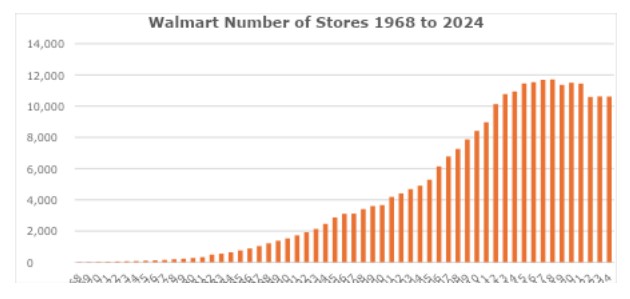Walmart's Transformative Ways Spark a 100,000% Stock Return
Walmart's strategic store expansion and relentless cost-cutting have catapulted its share price over the years.


Editor's note: This is part 12 of a 13-part series about companies whose shares have amassed 100,000% returns for investors and the path taken to generate such impressive gains over the long term. See below for links to the other stocks in this series.
From its humble beginnings as a small discount store in Rogers, Arkansas, Walmart (WMT) has grown into a global retail powerhouse, transforming the way the world shops.
How did a single store become the largest retailer in the world, with over $600 billion in annual revenue? The answer lies in Walmart's unique approach to expansion and its relentless focus on cost control.
From just $107.88 $24.99 for Kiplinger Personal Finance
Become a smarter, better informed investor. Subscribe from just $107.88 $24.99, plus get up to 4 Special Issues

Sign up for Kiplinger’s Free Newsletters
Profit and prosper with the best of expert advice on investing, taxes, retirement, personal finance and more - straight to your e-mail.
Profit and prosper with the best of expert advice - straight to your e-mail.
By strategically opening thousands of stores and mastering supply chain management, Walmart has consistently outperformed its competitors and reshaped the retail landscape.
To truly understand Walmart's success, we must examine these key areas: its aggressive store expansion and improvements in gross margins through cost-effective procurement. Together, these factors reveal the secrets behind Walmart's sustained growth and its ability to dominate the global market.
A major driver of Walmart's growth has been its aggressive expansion strategy. In 2000, Walmart operated 3,662 stores worldwide including Supercenters, discount stores, and Sam's Clubs.
By 2023, the number of stores had grown to 10,130. This rapid expansion allowed Walmart to capture a broad customer base across both urban and rural areas.

Looking at sales per store over time provides insights into Walmart's growth strategy.
In 2000, Walmart reported a revenue of approximately $167 billion. Dividing this by its 3,662 stores results in an average sales per store of around $45.6 million.
By 2023, Walmart's revenue had surged to nearly $611 billion. With over 10,623 stores, the average sales per store had risen to approximately $57.5 million. Over time, Walmart's methods allowed it to increase the productivity of each store by 26%.
Improving and maintaining gross margins has also been crucial to Walmart's ability to offer low prices and sustain profitability.
Walmart's massive scale allows it to negotiate better prices with suppliers, driving down the cost of goods sold and enhancing/maintaining gross margins. For a decade, Walmart has been able to keep its gross margin in the range of 24% to 26%.
You could almost say that Walmart is impervious to inflation, and that's one reason shoppers come back to Walmart again and again.
Amazingly, during the peak inflation of 2022, when the rate in the U.S. peaked at 9.1%, Walmart was able to maintain its gross margin at 24.1% that year, only 4% lower than the previous year's gross margin of 25.1%.
And when inflation abated in 2023, Walmart's gross margin was able to bounce back to 26.2%.
The company has leveraged its buying power to source goods at lower prices and invested in technology to enhance inventory management. These efforts have allowed Walmart to reduce the cost of goods sold and maintain its "Everyday Low Price" strategy, attracting price-sensitive customers and driving sales volume.
Despite economic fluctuations and changing market conditions, Walmart's ability to adapt and leverage its massive scale has enabled it to thrive.
As the largest retailer in the world, Walmart continues to shape the retail industry, demonstrating that a well-executed growth strategy and a relentless focus on cost control works.
The formula is still valid, and Walmart likely has more growth to deliver to shareholders.
Note: This content first appeared in Louis Navellier's latest book, The Sacred Truths of Investing: Finding Growth Stocks that Will Make You Rich, which was published by John Wiley & Sons, Inc.
Other 100,000% return stocks
- McDonald's Stock: How Small Changes Have Led to 100,000% Returns
- How Amazon Stock Became a Member of the 100,000% Return Club
- M&A Is Why UnitedHealth Group Stock Is a Member of the 100,000% Return Club
- Sherwin-Williams Is a Sleeper of the 100,000% Return Club
- Dealmaking Drives HEICO Stock's 100,000% Return
- Adobe Stock's Path to a 100,000% Return Is Impressive
- Apple's 100,000% Return Is a Result of Innovation, Brand Loyalty and Buybacks
- Home Depot's Winning Ways Fueled Its 100,000% Return
- It's No Surprise That Berkshire Hathaway's in the 100,000% Return Club
- Nvidia Stock's Been Growing for Years. Just Look At Its 100,000% Return
- Relentless Leadership Drives Oracle Stock's 100,000% Return
Profit and prosper with the best of Kiplinger's advice on investing, taxes, retirement, personal finance and much more. Delivered daily. Enter your email in the box and click Sign Me Up.

-
 I'm want to give my 3 grandkids $5K each for Christmas.
I'm want to give my 3 grandkids $5K each for Christmas.You're comfortably retired and want to give your grandkids a big Christmas check, but their parents are worried they might spend it all. We ask the pros for help.
-
 If You're Not Doing Roth Conversions, You Need to Read This
If You're Not Doing Roth Conversions, You Need to Read ThisRoth conversions and other Roth strategies can be complex, but don't dismiss these tax planning tools outright. They could really work for you and your heirs.
-
 Could Traditional Retirement Expectations Be Killing Us?
Could Traditional Retirement Expectations Be Killing Us?A retirement psychologist makes the case: A fulfilling retirement begins with a blueprint for living, rather than simply the accumulation of a large nest egg.
-
 I'm a Financial Planner: If You're Not Doing Roth Conversions, You Need to Read This
I'm a Financial Planner: If You're Not Doing Roth Conversions, You Need to Read ThisRoth conversions and other Roth strategies can be complex, but don't dismiss these tax planning tools outright. They could really work for you and your heirs.
-
 Could Traditional Retirement Expectations Be Killing Us? A Retirement Psychologist Makes the Case
Could Traditional Retirement Expectations Be Killing Us? A Retirement Psychologist Makes the CaseA retirement psychologist makes the case: A fulfilling retirement begins with a blueprint for living, rather than simply the accumulation of a large nest egg.
-
 I'm a Financial Adviser: This Is How You Can Adapt to Social Security Uncertainty
I'm a Financial Adviser: This Is How You Can Adapt to Social Security UncertaintyRather than letting the unknowns make you anxious, focus on building a flexible income strategy that can adapt to possible future Social Security changes.
-
 I'm a Financial Planner for Millionaires: Here's How to Give Your Kids Cash Gifts Without Triggering IRS Paperwork
I'm a Financial Planner for Millionaires: Here's How to Give Your Kids Cash Gifts Without Triggering IRS PaperworkMost people can gift large sums without paying tax or filing a return, especially by structuring gifts across two tax years or splitting gifts with a spouse.
-
 'Boomer Candy' Investments Might Seem Sweet, But They Can Have a Sour Aftertaste
'Boomer Candy' Investments Might Seem Sweet, But They Can Have a Sour AftertasteProducts such as index annuities, structured notes and buffered ETFs might seem appealing, but sometimes they can rob you of flexibility and trap your capital.
-
 AI Stocks Lead Nasdaq's 398-Point Nosedive: Stock Market Today
AI Stocks Lead Nasdaq's 398-Point Nosedive: Stock Market TodayThe major stock market indexes do not yet reflect the bullish tendencies of sector rotation and broadening participation.
-
 Got $100 to Gamble? These Penny Stocks Could Be Worth the Ride
Got $100 to Gamble? These Penny Stocks Could Be Worth the RideVolatile penny stocks are high-risk plays with potentially high rewards. If you have $100 you can afford to lose, these three names are worth a look.
-
 Quick Question: Are You Planning for a 20-Year Retirement or a 30-Year Retirement?
Quick Question: Are You Planning for a 20-Year Retirement or a 30-Year Retirement?You probably should be planning for a much longer retirement than you are. To avoid running out of retirement savings, you really need to make a plan.